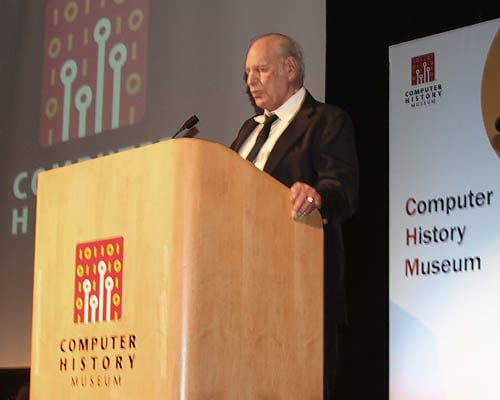This article is more than 1 year old
Sputnik, spaghetti and the IBM SPACE machine
The 50th anniversary of the 1401
The chief architect
Except that it did. To replace the WWAM, IBM turned to a system design sketched out by a single man working in Branscomb's Endicott lab. "I was called the chief architect of the 1401," Francis Underwood says. "But as a matter of fact, that was a made-up title. It wasn't official. It implies there were lots of other non-chief architects floating around. But they're weren't any."
The line is played for laughs. And Underwood goes on to praise the contributions of countless other IBMers in actually getting the system built. But in pegging himself the sole architect, he isn't far from the truth. Branscomb calls him the project's "creative fire".
After a stint in the Navy and a 75-cents-an-hour job as a tool maker in Washington, DC, Underwood was hired by IBM as a "customer engineer," someone who would answer the needs of the contracted clientele. But in his spare time, he designed machines of his own, "breaking out the old drawing board" when he came home in the evenings.

Francis Underwood
Eventually, he shared two designs to his supervisor: one for calculating keypunch, a device that could not only punch holes in the machine-readable data cards of the day but also make calculations on its own, and another for a newfangled interpreter, something that could both read cards and print to them. The supervisor sat on both. But within a week, Underwood had arranged his own interview with the lab in Endicott, and that nameless supervisor was soon left behind.
In Endicott, Underwood would join IBM's advanced systems development department, a group of engineers and mathematicians charged with predicting the future. "We were supposed to figure out what was coming ten years out," Underwood says. "But what we really did was screw around - and pretend we knew what we were talking about."
If Underwood screwed around, that wasn't all he did. Under the advanced systems aegis, he would lay out the design for what would become the 1401. Appropriately enough, he called it the SPACE project, short for Stored-Program Accounting and Calculating Equipment. Like the Gamma 3, it combined accounting machine with calculator. But unlike the Gamma - and unlike the WWAM - it didn't use a plugboard.
"We weren't interested in building an accounting machine," Branscomb says. "We wanted to take people to a whole new world."
